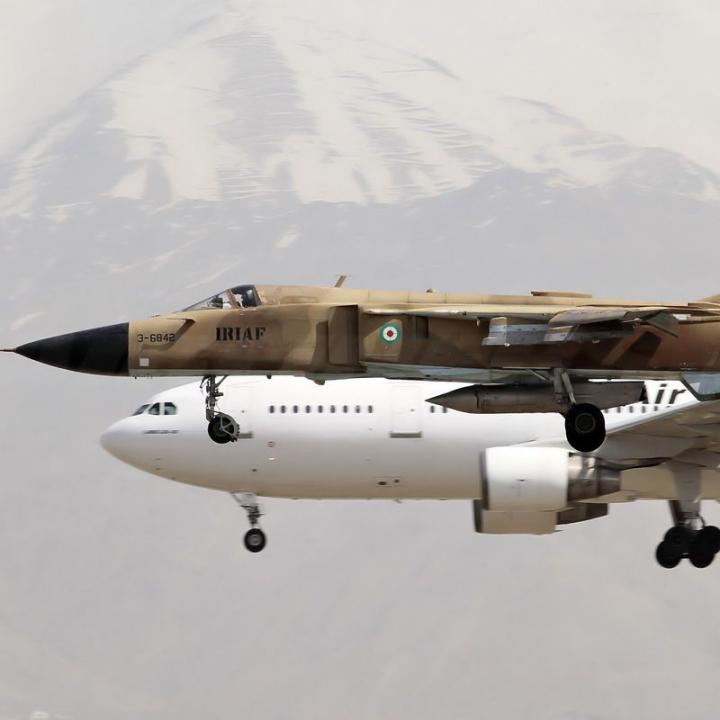

Newly disclosed interviews indicate that a key Pakistani source of Iran’s nuclear know-how also figured out how to equip F-16s with nukes.
In the debate about Iran’s nuclear weapon potential, the argument is frequently made that even if the regime achieves the ability to carry out a nuclear test, designing a deliverable missile warhead would still require an estimated two years of additional work. Indeed, developing a warhead capable of withstanding the stresses and temperatures of atmospheric reentry may be just as technically complex as designing a nuclear implosion device.
Yet this argument does not consider the possibility that Iran could use an aircraft as the delivery system instead of a missile. After all, this was the method used for the first atomic bombs dropped on Japan and for large parts of the nuclear forces developed by capable nations in subsequent years. Aircraft are no longer favored today as they are vulnerable to interception and raise various command-and-control issues; instead, nuclear-tipped missiles have come to dominate modern arsenals. Yet airborne methods might still appeal to Iran, since even a fighter jet can carry a comparatively small but powerful tactical nuclear weapon intended for battlefield use (though the regime lacks the heavy bombers needed to deliver strategic weapons).
A comparison with Pakistan, the source of Iran’s original centrifuge enrichment technology, is relevant. By 1984, Islamabad’s nuclear program had advanced to the point where its late director, Dr. A. Q. Khan, informed military dictator Muhammad Zia ul-Haq that he successfully cold-tested a weapon design, substituting tungsten for the high-enriched uranium used in an actual bomb. The program had also generated a small stockpile of enriched nuclear material.
Washington was aware of Pakistan’s progress and grew concerned that American-supplied F-16s could be used in a nascent nuclear strike force to counter India, which had carried out a so-called “peaceful nuclear explosion” in 1974. In a 1985 Financial Times article headlined “U.S. Urges Zia to Cut Military Emphasis in Next Aid Request,” this author quoted intelligence officials stating that “Pakistan is working on the manufacture of an atomic bomb suitable for carrying by an F-16.” The article also noted that Islamabad had “expressed interest...in the latest models of the F-16 fighter bomber, and conversion kits to make Boeing 707 passenger aircraft...into in-flight refueling tankers.”
Additional details about Pakistan’s early capabilities are described in Compulsions of Power, a new book consisting of interviews with Zia’s former military deputy, Gen. Mirza Aslam Beg, who is currently retired in Rawalpindi. One passage notes that Khan “successfully developed the delivery system...through which atomic weapons could be carried and delivered to the desired targets by F-16 aircraft.” Later, Beg claims that “the experiment of delivery system succeeded in August 1987.”
In 1988, Beg became Pakistan’s top military commander after Zia died in a mysterious plane crash along with U.S. ambassador Arnold Raphel, military attache Brig. Gen. Herbert Wassom, and others. Although Beg retired just three years later, his perceived support for Iran has continued to raise controversy. For example, after Qasem Soleimani, the head of Iran’s Islamic Revolutionary Guard Corps-Qods Force (IRGC-QF), was killed by a U.S. drone strike in January 2020, a photo dated to the 1980s began circulating on Twitter of Beg in uniform shaking hands with the young Soleimani, who was allegedly visiting Pakistan for training. The new biography contains a similar photo of the two men and quotes Beg as saying: “The fact is that a delegation of the Iranian Pasdaran e Inqilab [i.e., the IRGC] came to Pakistan in 1989 under the head of General Mohsin Rajai. [Soleimani] was also with them.”
Although there are no public indications that Iran is working on an aircraft delivery system, the possibility is worth discussing given that Tehran has the necessary aircraft and is known to have worked closely with Pakistan on nuclear technology and military matters. The Beg biography also reopens the question of whether Dr. Khan—who was buried this October with full military honors and a wreath from the current chief of army staff—was really a rogue proliferator or someone who acted with the encouragement of at least parts of the military and government.
Simon Henderson is the Baker Fellow and director of the Bernstein Program on Gulf and Energy Policy at The Washington Institute.



